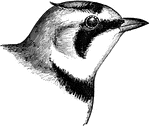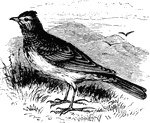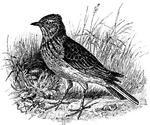Clipart tagged: ‘larks’

Shore Lark
"Shore Lark or Horned Lark. Upper parts in general pinkish-brown, this pinkish or vinaceous or liliaceous…

Shore Lark
"Shore Lark or Horned Lark. Upper parts in general pinkish-brown, this pinkish or vinaceous or liliaceous…

Skylark
"Alauda arvensis, the Sky-Lark, breed in Britain. The normal coloration is light-brown with darker longitudinal…

Skylark
"Sky-Lark. Upper parts grayish-brown, the feathers with darker centers; under parts whitish, tinged…

Skylark
"The common lark of Europe, Alauda arvensis: so called because it mounts toward the sky and sings as…